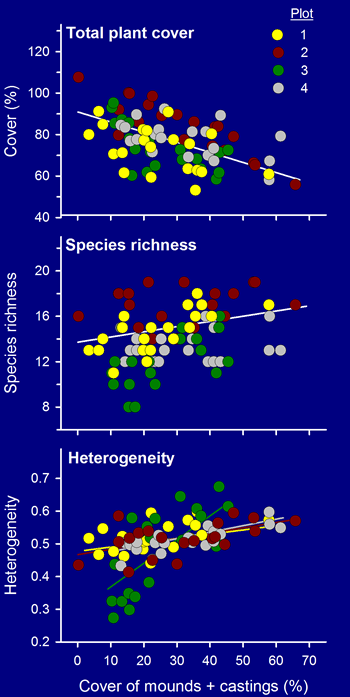| Results
Rates of disturbance. 60-70% of quadrats contained some form of disturbance. Mound cover averaged 12-21% across plots, castings 9-14%, and total disturbance 25-33%.
Relationships with total disturbance.
Total plant cover declined, but species richness and heterogeneity increased with total disturbance (figure, right). Contributions of mounds and castings. Both mounds and castings reduced plant cover, but their effects on plant growth forms differed (table, below). Mounds reduced graminoid cover, increased relative abundance of forbs (forb:graminoid ratio), and increased heterogeneity. Castings influenced only richness (positive effect).
Effects of mounds and castings on plant community structure.
ns = non-significant. |
 |
Conclusions
By considering patterns at larger spatial scales and isolating the effects of mounds vs. castings, our study yields new insights into the contributions of gopher disturbance to plant community structure.
Although castings reduce plant cover (as do mounds), the effects are transient and non-selective with respect to growth form. Mounds, which are larger, denser, and more persistent, differentially affect forbs and graminoids (see plant succession on gopher mounds).
Gopher disturbance also reduces species richness locally (on individual mounds), but it enhances richness and heterogeneity at larger spatial scales, by providing opportunities for rarer species to establish and for random colonization events to create differing assemblages of species.
| Case,
M. F., C. B. Halpern, and S. A. Levin. 2013. Contributions of gopher mound and casting disturbances to plant
community structure in a Cascade Range meadow complex. Botany 91:555-561. Request reprint |
|
| Effects of gopher disturbance |
 |
| Relationships between total disturbance (cover of mounds plus castings) and meadow community structure. Points represent transect values (n = 20 per plot). A single regression line is shown when plots had a common slope; separate lines indicate differing slopes. |
|
|
 |
![]()
![]()
![]()
![]()
_Jul 5 2011.jpg)

